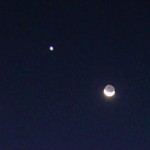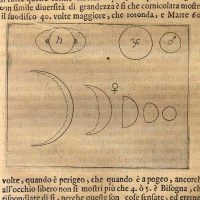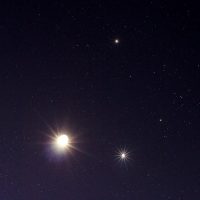
Tag: Venus
The Moon and Venus
Tomorrow morning, June 20th, a pretty crescent Moon will be located close to a brilliant Venus. The Moon will be a slim 18% crescent a little under 6° from Venus shining at -4.2 magnitude. The pair will rise about three hours before sunrise at about 2am, look for the two above the brightening glow of dawn.

Venus at Maximum Elongation
Today Venus is at maximum elongation, as high in the dawn sky as it will get for this morning apparition, about 45.9°. After today the planet will begin its slide back into the glare of dawn. It will disappear from view around the end of the year and reach superior conjunction on January 8th, 2018.
As Earth and Venus race about the Sun, Venus will complete about one cycle of appearances each year. We can expect one evening apparition and one morning apparition to occur in 2017.
The Moon and Venus
Tomorrow morning, May 22nd, a pretty crescent Moon will be located close to a brilliant Venus. The Moon will be a slim 15% crescent a little over 3° from Venus shining at -4.4 magnitude. The pair will rise about two hours before sunrise at about 3am, look for the two above the brightening glow of dawn.

The Moon and Venus
Tomorrow morning, April 23rd, a pretty crescent Moon will be located close to a brilliant Venus. The Moon will be a slim 12% crescent a little over 7° from Venus shining at -4.3 magnitude. The pair will rise about an hour before sunrise at about 4am, look for the two just above the brightening glow of dawn.

Venus Appears in the Dawn
The bright planet Venus will appear in the dawn sky over the next couple weeks, climbing higher to become the morning star for the remainder of 2017. It is currently 15° from the Sun and shining at magnitude -4.3, bright enough to be seen against the dawn sky. It will reach maximum elongation on June 3rd, 46° ahead of the rising Sun.
Venus Events for 2017 |
||||
|---|---|---|---|---|
| Date UT | Separation | Mag | ||
| Maximum Elongation | Jan 12 | 47.1°E | -4.4 | |
| Inferior Conjunction | Mar 25 | |||
| Maximum Elongation | Jun 3 | 45.9°W | -4.3 | |
| Source: NASA Sky Calendar | ||||
Venus at Inferior Conjunction
Today Venus is at inferior conjunction, passing between the Earth and Sun. It will reappear in the dawn sky early next month to become the morning star for the remainder of 2017. The planet will reach maximum elongation on June 3rd at 46° from the Sun.

Venus Exits the Evening Sky
Over the next week Venus will be lost to the Sun’s glare. It is currently about 15° east of the Sun, but getting closer quite quickly now and becoming tough to spot in the sunset. The planet will pass through inferior conjunction on March 25th. The planet will appear in the dawn sky around mid April. When it does appear, it will spend the remainder of 2017 as the morning star.

Venus Events for 2017 |
||||
|---|---|---|---|---|
| Date UT | Separation | Mag | ||
| Maximum Elongation | Jan 12 | 47.1°E | -4.4 | |
| Inferior Conjunction | Mar 25 | |||
| Maximum Elongation | Jun 3 | 45.9°W | -4.3 | |
| Source: NASA Sky Calendar | ||||
Venus Becomes a Crescent
Even when Venus is high in the sky and well placed for observation I will seldom take the effort of turning a telescope towards the planet. Why? Because Venus is pretty boring to look at. Perpetually cloud covered it has all the detail of a cue ball. It is a white disk with nothing of note to be seen. Yeah, pretty boring. Now turn the telescope to Jupiter.

This begins as the planet passes maximum eastern elongation, about two months before inferior conjunction. At this point the planet is seen from the side with respect to the sunlight, the planet will be about half illuminated. In the weeks after maximum elongation the planet will appear ever more crescent.


It is possible to enjoy this sight in the daytime, while the planet is high in the sky, the seeing can be better and the view sharper. Of course this also occurs when the planet is near the Sun, thus extreme caution should be practiced at the telescope to avoid any direct sunlight and possible eye damage.

While the the evidence challenged prevailing ideas of the time, some astronomers attempted to explain the phases of Venus by any other means to preserve their Earth centered universe, which led to rather tortured models of planetary motion. But it was clear to most that Galileo was right, the simple and elegant answer was that the Sun lay at the center. The orbits of Mercury and Venus, the phases, along with other observations like the moons of Jupiter, were hard evidence that few could ignore.
In 2017, eastern elongation occurred on January 12th. By now Venus has begun to show a substantial crescent, about 30% illuminated if you look today, Feb 12th. Over the next few weeks as the planet sinks into the sunset, the crescent aspect will thin dramatically.
By the end of February the planet will be only 17% illuminated, another week after that it becomes only 11%, by which time the planet will be difficult to spot in the sunset. Inferior conjunction will occur on March 25th. A couple weeks later and it will be possible to spot the planet in the dawn and observe the now thickening crescent.
Venus Events for 2017 |
||||
|---|---|---|---|---|
| Date UT | Separation | Mag | ||
| Maximum Elongation | Jan 12 | 47.1°E | -4.4 | |
| Inferior Conjunction | Mar 25 | |||
| Maximum Elongation | Jun 3 | 45.9°W | -4.3 | |
| Source: NASA Sky Calendar | ||||
The Moon, Venus and Mars

Look for the trio in the western sky this evening just after sunset, it will be nearly impossible to overlook. You have plenty of time to enjoy the show as the trio will not set until around 9:30pm.
